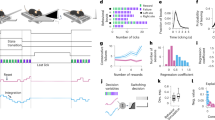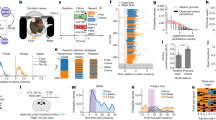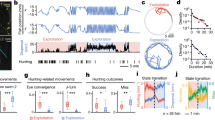Abstract
Modern decision neuroscience offers a powerful and broad account of human behaviour using computational techniques that link psychological and neuroscientific approaches to the ways that individuals can generate near-optimal choices in complex controlled environments. However, until recently, relatively little attention has been paid to the extent to which the structure of experimental environments relates to natural scenarios, and the survival problems that individuals have evolved to solve. This situation not only risks leaving decision-theoretic accounts ungrounded but also makes various aspects of the solutions, such as hard-wired or Pavlovian policies, difficult to interpret in the natural world. Here, we suggest importing concepts, paradigms and approaches from the fields of ethology and behavioural ecology, which concentrate on the contextual and functional correlates of decisions made about foraging and escape and address these lacunae.
This is a preview of subscription content, access via your institution
Access options
Access Nature and 54 other Nature Portfolio journals
Get Nature+, our best-value online-access subscription
$29.99 / 30 days
cancel any time
Subscribe to this journal
Receive 12 print issues and online access
$189.00 per year
only $15.75 per issue
Buy this article
- Purchase on Springer Link
- Instant access to full article PDF
Prices may be subject to local taxes which are calculated during checkout


Similar content being viewed by others
References
Krebs, J. R. & Davies, N. B. An Introduction To Behavioural Ecology (Blackwell Scientific Publications, 1993).
Cooper, W. E. Jr & Blumstein, D. T. Escaping From Predators: An integrative View Of Escape Decisions (Cambridge University Press, 2015).
Ydenberg, R. C., Brown, J. S. & Stephens, D. W. Foraging: Behavior And Ecology (The University of Chicago Press, 2007).
Charnov, E. L. Optimal foraging, the marginal value theorem. Theor. Popul. Biol. 9, 129–136 (1976).
Fretwell, S. D. & Lucas, H. L. Jr On territorial behavior and other factors influencing habitat distribution in birds. Acta Biotheor. 19, 16–36 (1970).
Pompilio, L., Kacelnik, A. & Behmer, S. T. State-dependent learned valuation drives choice in an invertebrate. Science 311, 1613–1615 (2006).
Krebs, J. R., Kacelnik, A. & Taylor, P. Test of optimal sampling by foraging great tits. Nature 275, 27–31 (1978).
Ratcliff, R., Smith, P. L., Brown, S. D. & McKoon, G. Diffusion decision model: current issues and history. Trends Cogn. Sci. 20, 260–281 (2016).
Gold, J. I. & Shadlen, M. N. The neural basis of decision making. Annu. Rev. Neurosci. 30, 535–574 (2007).
Rescorla, R. A. & Wagner, A. R. in Classical Conditioning II: Current Theory and Research (eds Black, A. H. & Prokasy, W. F.) 64–99 (Appleton-Century-Crofts, 1972).
Sutton, R. S. & Barto, A. Reinforcement Learning: An Introduction (MIT Press, 1998).
Montague, P. R., Dayan, P. & Sejnowski, T. J. A framework for mesencephalic dopamine systems based on predictive Hebbian learning. J. Neurosci. 16, 1936–1947 (1996).
Hayden, B. Y., Pearson, J. M. & Platt, M. L. Neuronal basis of sequential foraging decisions in a patchy environment. Nat. Neurosci. 14, 933–939 (2011).
Mobbs, D. et al. Foraging under competition: the neural basis of input matching in humans. J. Neurosci. 33, 9866–9872 (2013).
Kolling, N., Behrens, T. E. J., Mars, R. B. & Rushworth, M. F. S. Neural mechanisms of foraging. Science 336, 95–98 (2012).
Constantino, S. M. & Daw, N. D. Learning the opportunity cost of time in a patch-foraging task. Cogn. Affect. Behav. Neurosci. 15, 837–853 (2015).
Shenhav, A., Straccia, M. A., Cohen, J. D. & Botvinick, M. M. Anterior cingulate engagement in a foraging context reflects choice difficulty, not foraging value. Nat. Neurosci. 17, 1249–1254 (2014).
Brase, G. L. Behavioral science integration: a practical framework of multi-level converging evidence for behavioral science theories. New Ideas Psychol. 33, 8–20.
Anderson, D. & Perona, P. Toward a science of computational ethology. Neuron 84, 18–31 (2014).
Daw, N. D., O’Doherty, J. P., Dayan, P., Seymour, B. & Dolan, R. J. Cortical substrates for exploratory decisions in humans. Nature 441, 876–879 (2006).
Barch, D. M. et al. Dissociating working memory from task difficulty in human prefrontal cortex. Neuropsychologia 35, 1373–1380 (1997).
Daw, N. D., Gershman, S. J., Seymour, B., Dayan, P. & Dolan, R. J. Model-based influences on humans’ choices and striatal prediction errors. Neuron 69, 1204–1215 (2011).
King-Casas, B. et al. Getting to know you: reputation and trust in a two-person economic exchange. Science 308, 78–83 (2005).
Frederick, S., Loewenstein, G. & O’donoghue, T. Time discounting and time preference: a critical review. J. Econ. Lit. 40, 351–401 (2002).
Ainslie, G. & Haslam, N. in Choice Over Time (eds Loewenstein, G. & Elster, J.) 57–92 (Russell Sage Foundation, 1992).
Pearson, J. M., Watson, K. K. & Platt, M. L. Decision making: the neuroethological turn. Neuron 82, 950–965 (2014).
Santos, L. R. & Rosati, A. G. The evolutionary roots of human decision making. Annu. Rev. Psychol. 66, 321–347 (2015).
Volz, K. G. & Gigerenzer, G. Cognitive processes in decisions under risk are not the same as in decisions under uncertainty. Front. Neurosci. 6, 105 (2012).
McNamara, J. M. & Houston, A. I. Integrating function and mechanism. Trends Ecol. Evol. 24, 670–675 (2009).
Lima, S. L. & Bednekoff, P. A. Temporal variation in danger drives antipredator behavior: the predation risk allocation hypothesis. Am. Nat. 153, 649–659 (1999).
Stephens, D. W. & Krebs, J. R. Foraging Theory (Princeton University Press, 1986).
Caraco, T., Martindale, S. & Whittam, T. S. An empirical demonstration of risk-sensitive foraging preferences. Anim. Behav. 28, 820–830 (1980).
Houston, A. I. & McNamara, J. M. Models Of Adaptive Behaviour, An Approach Based On State (Cambridge University Press, 1999).
LeDoux, J. Rethinking the emotional brain. Neuron 73, 653–676 (2012).
White, D. W., Dill, L. M. & Crawford, C. B. A. Common, conceptual framework for behavioral ecology and evolutionary psychology. Evol. Psychol. 5, 275–288 (2007).
Elner, R. W. & Hughes, R. N. Energy maximization in the diet of the shore crab, carcinus maenas. J. Anim. Ecol. 47, 103 (1978).
Kacelnik, A. Central place foraging in starlings (Sturnus vulgaris). I. Patch residence time. J. Anim. Ecol. 53, 283 (1984).
Switzer, P. V. & Cristol, D. A. Avian prey-dropping behavior I: effects of prey characteristics and prey loss. Behav. Ecol. 10, 213–219 (1999).
Walton, M. E., Croxson, P. L., Rushworth, M. F. S. & Bannerman, D. M. The mesocortical dopamine projection to anterior cingulate cortex plays no role in guiding effort-related decisions. Behav. Neurosci. 119, 323–328 (2005).
Kennerley, S. W., Behrens, T. E. J. & Wallis, J. D. Double dissociation of value computations in orbitofrontal and anterior cingulate neurons. Nat. Neurosci. 14, 1581–1589 (2011).
Pessiglione, M. et al. How the brain translates money into force: a neuroimaging study of subliminal motivation. Science 316, 904–906 (2007).
Kool, W. & Botvinick, M. A labor/leisure tradeoff in cognitive control. J. Exp. Psychol. Gen. 143, 131–141 (2014).
Croxson, P. L., Walton, M. E., O’Reilly, J. X., Behrens, T. E. J. & Rushworth, M. F. S. Effort-based cost-benefit valuation and the human brain. J. Neurosci. 29, 4531–4541 (2009).
Kurniawan, I. T., Guitart-Masip, M., Dayan, P. & Dolan, R. J. Effort and valuation in the brain: the effects of anticipation and execution. J. Neurosci. 33, 6160–6169 (2013).
Walton, M. E., Bannerman, D. M., Alterescu, K. & Rushworth, M. F. S. Functional specialization within medial frontal cortex of the anterior cingulate for evaluating effort-related decisions. J. Neurosci. 23, 6475–6479 (2003).
Rudebeck, P. H., Walton, M. E., Smyth, A. N., Bannerman, D. M. & Rushworth, M. F. S. Separate neural pathways process different decision costs. Nat. Neurosci. 9, 1161–1168 (2006).
Blain, B., Hollard, G. & Pessiglione, M. Neural mechanisms underlying the impact of daylong cognitive work on economic decisions. Proc. Natl Acad. Sci. USA 113, 6967–6972 (2016).
Parvizi, J., Rangarajan, V., Shirer, W. R., Desai, N. & Greicius, M. D. The will to persevere induced by electrical stimulation of the human cingulate gyrus. Neuron 80, 1359–1367 (2013).
Kolling, N. & Akam, T. (Reinforcement?) Learning to forage optimally. Curr. Opin. Neurobiol. 46, 162–169 (2017).
Hutchinson, J. M. C., Wilke, A. & Todd, P. M. Patch leaving in humans: can a generalist adapt its rules to dispersal of items across patches? Anim. Behav. 75, 1331–1349 (2008).
Wilke, A., Hutchinson, J. M. C., Todd, P. M. & Czienskowski, U. Fishing for the right words: decision rules for human foraging behavior in internal search tasks. Cogn. Sci. 33, 497–529 (2009).
Stephens, D. W. & Anderson, D. The adaptive value of preference for immediacy: when shortsighted rules have farsighted consequences. Behav. Ecol. 12, 330–339 (2000).
Pirolli, P. & Card, S. Information foraging. Psychol. Rev. 106, 643–675 (1999).
Turrin, C., Fagan, N. A., Dal Monte, O. & Chang, S. W. C. Social resource foraging is guided by the principles of the marginal value theorem. Sci. Rep. 7, 11274 (2017).
Hills, T. T., Jones, M. N. & Todd, P. M. Optimal foraging in semantic memory. Psychol. Rev. 119, 431–440 (2012).
Krebs, J. R., Erichsen, J. T., Webber, M. I. & Charnov, E. L. Optimal prey selection in the great tit (Parus major). Anim. Behav. 25, 30–38 (1977).
Shenhav, A., Cohen, J. D. & Botvinick, M. M. Dorsal anterior cingulate cortex and the value of control. Nat. Neurosci. 19, 1286–1291 (2016).
Kolling, N. et al. Value, search, persistence and model updating in anterior cingulate cortex. Nat. Neurosci. 19, 1280–1285 (2016).
Wright, N. D. et al. Human responses to unfairness with primary rewards and their biological limits. Sci. Rep. 2, 593 (2012).
Williams, E. F., Pizarro, D., Ariely, D. & Weinberg, J. D. The Valjean effect: visceral states and cheating. Emotion 16, 897–902 (2016).
Chib, V. S., Rangel, A., Shimojo, S., & O’Doherty, J. P. Evidence for a common representation of decision values for dissimilar goods in human ventromedial prefrontal cortex. J. Neurosci. 39, 12315–12320 (2009).
D’Ardenne, K., McClure, S. M., Nystrom, L. E. & Cohen, J. D. BOLD responses reflecting dopaminergic signals in the human ventral tegmental area. Science 1264–1267 (2008).
Izuma, K., Saito, D. N. & Sadato, N. Processing of social and monetary rewards in the human striatum. Neuron 58, 284–294 (2008).
Nash, J. F. Non-cooperative games. Ann. Math. 54, 286–295 (1951).
Von Neumann, J. & Morgenstern, O. Theory Of Games And Economic Behavior (Princeton University Press, 2007).
Barnard, C. J. & Sibly, R. M. Producers and scroungers: a general model and its application to captive flocks of house sparrows. Anim. Behav. 29, 543–550 (1981).
Maynard Smith, J. Evolution And The Theory of Games (Cambridge University Press, 1982).
Kennedy, M. & Gray, R. D. Can ecological theory predict the distribution of foraging animals? A critical analysis of experiments on the ideal free distribution. Oikos 68, 158 (1993).
Harper, D. G. C. Competitive foraging in mallards: ‘ideal free’ ducks. Anim. Behav. 30, 575–584 (1982).
Lima, S. L. & Dill, L. M. Behavioral decisions made under the risk of predation: a review and prospectus. Can. J. Zool. 68, 619–640 (1990).
Abrahams, M. V., Dill, L. M., Abrahams, M. V. & Dill, L. M. A determination of the energetic equivalence of the risk of predation. Ecology 70, 999–1007 (1989).
Lima, S. L. & Valone, T. J. Influence of predation risk on diet selection: a simple example in the grey squirrel. Anim. Behav. 34, 536–544 (1986).
McNamara, J. M. & Houston, A. I. A common currency for behavioral decisions. Am. Nat. 127, 358–378 (1986).
Fisher, R. A. The Genetical Theory Of Natural Selection (Dover, 1958).
Mangel, M. & Clark, C. W. Dynamic Modeling In Behavioural Ecology (Princeton University Press, 1988).
Ydenberg, R. C. & Dill, L. M. Advances In The Study Of Behavior (eds Rosenblatt, J. S., Beer, C., Busnelz, M. C. & Slater, P. J. B.) 229–249 (Elsevier, 1986).
Stankowich, T. & Blumstein, D. T. Fear in animals: a meta-analysis and review of risk assessment. Proc. Biol. Sci. 272, 2627–2634 (2005).
Mobbs, D. et al. When fear is near: threat imminence elicits prefrontal - periaqueductal grey shifts in humans. Science 317, 1079–1083 (2007).
Meyer, C. T., Padmala, S. & Pessoa, L. Tracking dynamic threat imminence. bioRxiv https://doi.org/10.1101/183798 (2017).
Mobbs, D. et al. From threat to fear: the neural organization of defensive fear systems in humans. J. Neurosci. 29, 12236–12243 (2009).
Gold, A. L., Morey, R. A. & McCarthy, G. Amygdala-prefrontal cortex functional connectivity during threat-induced anxiety and goal distraction. Biol. Psychiatry 77, 394–403 (2015).
Bach, D. R. et al. Human hippocampus arbitrates approach-avoidance conflict. Curr. Biol. 24, 1435 (2014).
Korn, C. W. et al. Amygdala lesions reduce anxiety-like behavior in a human benzodiazepine-sensitive approach-avoidance conflict test. Biol. Psychiatry 82, 522–531 (2017).
McNaughton, N. & Corr, P. J. A two-dimensional neuropsychology of defense: fear/anxiety and defensive distance. Neurosci. Biobehav. Rev. 28, 285–305 (2004).
Yilmaz, M. & Meister, M. Rapid innate defensive responses of mice to looming visual stimuli. Curr. Biol. 23, 2011–2015 (2013).
Vale, R., Evans, D. A. & Branco, T. Rapid spatial learning controls instinctive defensive behavior in mice. Curr. Biol. 27, 1342–1349 (2017).
Blanchard, D. C. Translating dynamic defense patterns from rodents to people. Neurosci. Biobehav. Rev. 76, 22–28 (2017).
Qi, S. et al. How cognitive and reactive fear circuits optimize escape decisions in humans. Proc. Natl Acad. Sci. USA 115, 3186–3191 (2018).
Shackman, A. J. et al. The integration of negative affect, pain and cognitive control in the cingulate cortex. Nat. Rev. Neurosci. 12, 154–167 (2011).
Mikhael, J. G. & Bogacz, R. Learning reward uncertainty in the basal ganglia. PLoS Comput. Biol. 12, e1005062 (2016).
Botvinick, M. & Braver, T. Motivation and cognitive control: from behavior to neural mechanism. Annu. Rev. Psychol. 66, 83–113 (2015).
Boureau, Y.-L., Sokol-Hessner, P. & Daw, N. D. Deciding how to decide: self-control and meta-decision making. Trends Cogn. Sci. 19, 700–710 (2015).
Reynolds, J. J. & McCrea, S. M. Environmental constraints on the functionality of inhibitory self-control: sometimes you should eat the donut. Self and Identity https://doi.org/10.1080/15298868.2017.1354066 (2017).
Nesse, R. M. An evolutionary perspective on psychiatry. Compr. Psychiatry 25, 575–580 (1984).
Perusini, J. N. & Fanselow, M. S. Neurobehavioral perspectives on the distinction between fear and anxiety. Learn. Mem. 22, 417–425 (2015).
Addicott, M. A., Pearson, J. M., Sweitzer, M. M., Barack, D. L. & Platt, M. L. A. Primer on foraging and the explore/exploit trade-off for psychiatry research. Neuropsychopharmacology 42, 1931–1939 (2017).
Addicott, M. A., Pearson, J. M., Kaiser, N., Platt, M. L. & McClernon, F. J. Suboptimal foraging behavior: a new perspective on gambling. Behav. Neurosci. 129, 656–665 (2015).
Trimmer, P. C., Higginson, A. D., Fawcett, T. W., McNamara, J. M. & Houston, A. I. Adaptive learning can result in a failure to profit from good conditions: implications for understanding depression. Evol. Med. Public Health 2015, 123–135 (2015).
Huys, Q. J. M., Daw, N. D. & Dayan, P. Depression: a decision-theoretic analysis. Annu. Rev. Neurosci. 38, 1–23 (2015).
Marsh, B. & Kacelnik, A. Framing effects and risky decisions in starlings. Proc. Natl Acad. Sci. USA 99, 3352–3355 (2002).
Monteiro, T., Vasconcelos, M. & Kacelnik, A. Starlings uphold principles of economic rationality for delay and probability of reward. Proc. Biol. Sci. 280, 20122386 (2013).
Kalenscher, T. & Pennartz, C. M. A. Is a bird in the hand worth two in the future? The neuroeconomics of intertemporal decision-making. Prog. Neurobiol. 84, 284–315 (2008).
Kahneman, D. & Tversky, A. Prospect theory: an analysis of decision under risk. Econometrica 47, 263 (1979).
Stamp Dawkins, M. Cognitive ecology: the evolutionary ecology of information processing and decision making. Trends Cogn. Sci. 2, 304 (1998).
Blumstein, D. T. et al. Toward an integrative understanding of social behavior: new models and new opportunities. Front. Behav. Neurosci. 4, 34 (2010).
Taborsky, M. et al. Taxon matters: promoting integrative studies of social behavior: NESCent working group on integrative models of vertebrate sociality: evolution, mechanisms, and emergent properties. Trends Neurosci. 38, 189–191 (2015).
Tinbergen, N. On aims and methods in ethology. Z. Tierpsychol. 20, 410–433 (1963).
Marr, D. & Poggio, T. A computational theory of human stereo vision. Proc R Soc B Biol Sci 204, 301–328 (1979).
Camerer, C. & Mobbs, D. Comparing cognitive and neural processes during hypothetical and real choices. Trends Cogn. Sci. 21, 46–56 (2017).
Mayr, E. Cause and effect in biology: kinds of causes, predictability, and teleology are viewed by a practicing biologist. Science 134, 1501–1506 (1961).
Huxley, J. Evolution: The Modern Synthesis (MIT Press, 2010).
Price, D. J. & Willshaw, D. J. Mechanisms Of Cortical Development (Oxford Univ. Press, 2000).
Acknowledgements
The authors thank T. Akam and the reviewers for their very stimulating comments. This work was supported by US National Institute of Mental Health grant 2P50MH094258 and a Chen Institute Award (P2026052) (support to D.M.), the Gatsby Charitable Foundation (support to P.D.) and the US National Science Foundation (support to D.T.B. and P.C.T.; P.C.T. was supported by an Integrative Organismal System grant (1456724) to A. Sih). The content is solely the responsibility of the authors and does not necessarily represent the official views of the authors’ funders.
Competing interests
The authors declare no competing interests.
Author information
Authors and Affiliations
Contributions
D.M., P.C.T., D.T.B. and P.D. researched data for the article, made substantial contributions to discussions of the content, wrote the article and reviewed and/or edited the manuscript before submission.
Corresponding author
Additional information
Publisher’s note
Springer Nature remains neutral with regard to jurisdictional claims in published maps and institutional affiliations.
Rights and permissions
About this article
Cite this article
Mobbs, D., Trimmer, P.C., Blumstein, D.T. et al. Foraging for foundations in decision neuroscience: insights from ethology. Nat Rev Neurosci 19, 419–427 (2018). https://doi.org/10.1038/s41583-018-0010-7
Published:
Issue Date:
DOI: https://doi.org/10.1038/s41583-018-0010-7
This article is cited by
-
Hybrid Adaptive Systems
Business & Information Systems Engineering (2024)
-
What is foraging?
Biology & Philosophy (2024)
-
Evidence for optimal semantic search throughout adulthood
Scientific Reports (2023)
-
Freezing revisited: coordinated autonomic and central optimization of threat coping
Nature Reviews Neuroscience (2022)
-
Neural implementation of computational mechanisms underlying the continuous trade-off between cooperation and competition
Nature Communications (2022)



